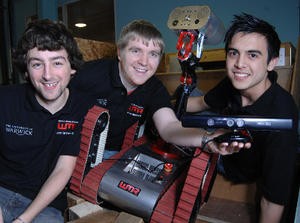Search and rescueEngineers use Xbox Kinect to find earthquake survivors
A team of engineers at the University of Warwick in the United Kingdom has been working to develop a robot capable of entering unstable buildings and searching for survivors, such as the 200 purportedly missing after the 6.3 magnitude earthquake in Christchurch, New Zealand; until now, technology has relied on expensive laser-based equipment, but Warwick’s team has reconfigured Microsoft’s Xbox Kinect to identify places in which survivors may be

Warwick engineering team with X-box rescue robot // Source: warwick.ac.uk
A team of engineers at the University of Warwick in the United Kingdom has been working to develop a robot capable of entering unstable buildings and searching for survivors, such as the 200 purportedly missing after the 6.3 magnitude earthquake in Christchurch, New Zealand. Until now, technology has relied on expensive laser-based equipment, but Warwick’s team has reconfigured Microsoft’s Xbox Kinect to identify places in which survivors may be.
“The whole idea is to protect the lives of the rescuers,” explained Peter Crook, mechanical engineer on the project. The motion-detection device means Warwick Mobile Robotics (WMR) have been able to create a robot which can accurately model its surroundings and even identify the potential location of survivors.
“What you’d have is a team of maybe two people - it doesn’t take a lot of manpower - and they’d set up outside,” said Crook. “From a safe distance, they’d drive the robot in and then use that robot to look for victims.”
Last year, the robot was awarded first place at the European RoboCup Rescue championship in Germany, a competition which seeks to give initiatives in this field the ability to gain publicity and funding.
The project is currently seeking further sponsorship, particularly for testing the device in real-life situations.
“They’re obviously hard to predict and we don’t have the money to fly out there,” said Crook, reflecting on the disaster in New Zealand.
“We raise all our own funding and so cost is a massive issue for us in what we can and can’t produce”.
Crook estimates that the team has saved over £2,000 ($3,261) per robot by using Kinect rather than other similar and less advanced technology. One can purchase the X-box peripheral device for $150. The camera transmits invisible near-infrared light and measures its “time of flight” after reflecting off objects.
Time-of-flight works like sonar: if you know how long the light takes to return, you know how far away an object is. The infrared generator also partially solves the problem of ambient light which cuts down on false positives.
“What we had before was a LIDAR - a laser range finder - but that then just gives you literally a planar view so you get a flat-line of how far things are away from you. Whereas the Kinect gives us a 3-D view so we can actually see like an image and how far everything is away.”
Despite Microsoft’s initial reluctance to allow their product to be used on something other than their Xbox console, the company now says it has changed its stance.
From the spring, a developer’s kit for the Kinect will be made available for personal users, while a commercial kit will follow at a later date.
“It’s definitely good news for us,” said Crook, welcoming the new approach.
WMR’s robot was only made possible after an independent programmer produced unofficial drivers which enabled the Kinect to be used on a normal computer.
“Essentially we’re using it for the function it’s designed for but applying it not to computer games but for saving lives.”
